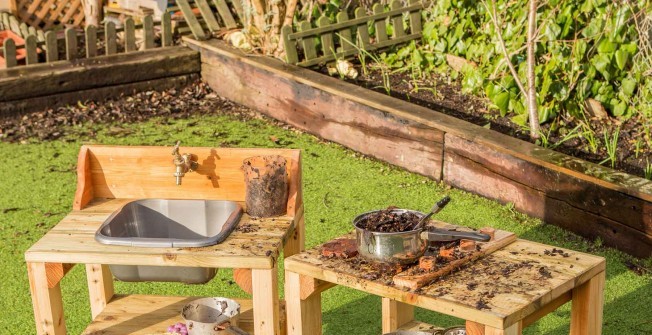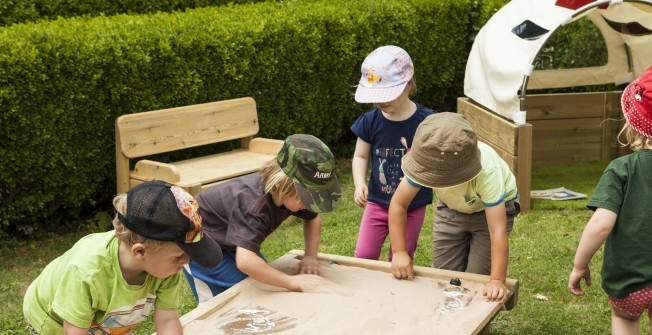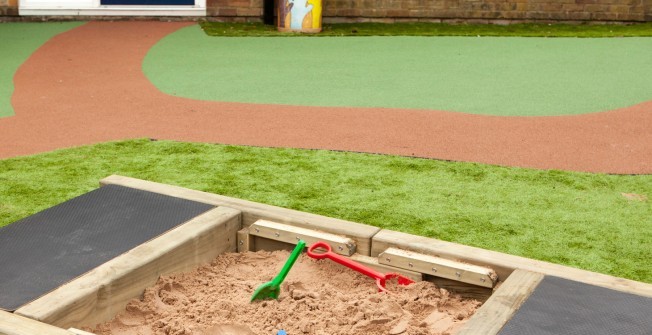


Sensory playground equipment offers a dynamic and engaging way for children to explore and learn through play in outdoor spaces.
It provides a stimulating environment where they can enhance their sensory experiences while having fun.
This innovative equipment includes tactile, auditory, visual, and vestibular elements that stimulate different senses.
Through interactive play structures like swings, slides, spinning platforms, and climbing walls, children can develop their motor skills, coordination, and spatial awareness.
The diverse textures, colours, and sounds incorporated in the playground equipment create a multisensory experience that encourages exploration and creativity.
Our experts can supply and install a range of sensory equipment, to find out more about the sensory playground equipment which we provide, please fill in the contact form on this page.
Sensory play is a type of activity which stimulates children's five main senses.
The five senses are sight, sound, touch, taste and smell.
This type of activity allows children to explore their surrounding areas by feeling different textures, creating musical sounds, smelling different scents and a variety of other things.
It is good for children to grasp and move objects with their hands and use their other senses, since it could help them develop.
Sensory activities are particularly good for youngsters with special needs that may require more assistance when learning motor skills like writing.
Sensory play equipment refers to specialised gear designed to engage children in sensory experiences that foster learning and fun. It includes various interactive elements aimed at stimulating the senses while providing an enjoyable play environment.
This equipment can encompass a wide range of items such as sand tables, water tables, sensory bins, textured mats, and more.
Each element is carefully crafted to encourage exploration, creativity, and cognitive development in young minds.
Through sensory play, children can enhance their motor skills, cognitive abilities, and emotional regulation while having a blast.
Furthermore, sensory play helps kids build their vocabulary as they describe different textures, smells, tastes, and sounds they encounter.
We provide a number of unique educational resources for those looking to help youngsters develop through using their senses.
Some more popular items we have include water play tables, sand pits, mud kitchens and musical instruments. These allow children to hear different noises and feel new textures. This is very important in early life development.
Sensory play holds immense importance for children as it contributes significantly to their educational and developmental growth.
Engaging in sensory activities helps children explore the world around them in meaningful ways.
Through sensory play, children can enhance their cognitive abilities, improve fine and gross motor skills, and develop their social and emotional intelligence.
By engaging in activities that involve touch, smell, taste, sight, and sound, youngsters can make connections between their senses and the environment.
This hands-on approach to learning not only fosters creativity but also aids in problem-solving skills and language development.
Sensory experiences help children regulate their emotions and enhance their concentration and focus.
Sensory play is integral to children's development, offering a myriad of benefits across cognitive, physical, social, and emotional domains. Key benefits include:
Sensory play is particularly beneficial for children with sensory processing issues, autism, or ADHD, offering tailored sensory experiences that can support their specific developmental needs.
Sensory playground equipment is designed to stimulate children's senses and support their cognitive development, social skills, and physical abilities. These types of equipment cater to various sensory experiences, including touch, sight, hearing, balance, and proprioception (sense of body position). Key types include:
Each type is designed to offer inclusive play opportunities, catering to children of all abilities, including those with sensory processing disorders or autism.
The average cost of sensory playground equipment is £2,000 - £15,000.
However, the cost of sensory playground equipment can vary depending on the type, size, and complexity of the equipment. Factors such as installation, design, and additional features also impact the overall cost.
When considering installation expenses, it's essential to account for labour costs, site preparation, and any necessary permits.
Complex installations may require specialised equipment, increasing the overall cost.
Design plays a crucial role in pricing. Custom designs and intricate structures tend to be more expensive than standard off-the-shelf options.
The materials used, such as durable plastics or weather-resistant metals, can also affect pricing.
The inclusion of additional features like interactive elements, sound systems, or sensory lighting can significantly raise the cost.
Whilst these features enhance the sensory experience, they come with a price tag that reflects their innovation and technology.
Creating a sensory playground involves careful planning and design to incorporate various sensory stimuli that engage all the senses. Here are steps and considerations to create an inclusive and stimulating sensory playground:
We provide a variety of outdoor sensory toys to help children grow and develop.
Some of the most popular toys include sand pits, mud kitchens and water tables. These all have different textures for the children to touch and feel.
This can help children develop in a number of different ways, which makes your school more likely to be marked better by OFSTED inspectors.
We would highly encourage schools to provide outdoor sense based toys to youngsters to improve key skills and help them learn and explore.
Our experts can offer a variety of sensory play ideas to stimulate children's senses. These might include things like finger painting and playing musical instruments.
We would recommend taking part in these types of activities outdoors, as some activities could be messy.
In order to make the most out of the area, we would highly recommend using spaces where children can make a lot of mess which can be cleaned up easily.
For more details on sensory play ideas, please complete the contact form provided and we'll get back to you as soon as possible.
Our experts have years of experience in the industry and will be happy to talk you through the different options available. We will also answer any questions you have got including prices and designs that could be created.
There are a range of messy play benefits which could help children develop key skills from a young age. Since it may be difficult for children to understand unique sensations within the environment, messy play activities can make it easier for them. Some messy play benefits include:
All of these benefits are great for children who have difficulty with learning abilities. Stimulating different senses is vital for both physical and mental skills.
If you need more information regarding the advantages of these activities please let us know.
Selecting the right sensory playground equipment involves considering factors such as age appropriateness, developmental benefits, and safety features.
Collaboration with teachers and partnerships with educational experts can aid in choosing equipment that aligns with learning objectives.
When selecting sensory playground equipment, it's crucial to take into account the specific age group that will be using the equipment.
For younger children, colourful and interactive elements that engage their senses are ideal, while older children might benefit from more challenging and stimulating options.
Understanding the developmental advantages of different equipment is vital. For example, equipment that encourages balance and coordination can help improve motor skills, while activities that promote problem-solving and creativity can boost cognitive development.
Prioritising safety considerations is non-negotiable. Ensuring that the equipment meets safety standards, such as soft landing surfaces and proper installation, is essential to prevent injuries and create a secure environment for play.
When choosing sensory playground equipment, it is crucial to consider children's age and developmental stage. This factor helps refine the search for equipment that offers the most appropriate sensory experiences based on developmental needs.
By taking into account the specific stages of growth and maturity of the child, parents, educators, and playground designers can curate a play environment that stimulates and supports individual development.
Understandably, a toddler's sensory requirements differ vastly from those of a pre-teen; thus, it's vital to select equipment that aligns with these unique needs.
Considering factors such as cognitive abilities, motor skills, and emotional development can ensure that the chosen equipment provides not only fun but also opportunities for learning and growth.
Taking into account children's sensory preferences is vital in choosing the right playground equipment.
Understanding how different sensory experiences stimulate children's senses can guide the selection of equipment that caters to their individual preferences.
For instance, incorporating elements that provide tactile sensations, such as textured surfaces or materials like sand and water, can offer tactile stimulation.
In addition, equipment that encourages vestibular input, like swings and spinning platforms, can help with balance and coordination development.
Moreover, auditory stimuli, such as musical instruments or interactive panels, can engage children's auditory senses, adding another dimension to their play experience.
By aligning playground equipment with these sensory preferences, children can explore, learn, and have fun in a holistic and enriching way.
Safety and durability are paramount considerations when choosing sensory playground equipment.
Ensuring that the equipment is safe for children to use and durable enough to withstand outdoor conditions is crucial for a positive play experience.
In terms of safety, selecting equipment that meets safety standards and guidelines is essential. Look for features such as rounded edges, secure fittings, and non-toxic materials to minimise the risk of injuries.
Additionally, regular maintenance and inspection routines are crucial to ensure that the equipment remains safe over time.
For durability, opt for materials like stainless steel, powder-coated aluminium, or heavy-duty plastic that can withstand various weather conditions and heavy use.
Reinforced joints and sturdy construction are also key factors that contribute to the longevity of the equipment.
Opting for multi-sensory playground equipment provides children with diverse and engaging play experiences.
These options offer a variety of stimulating activities that cater to different senses, creating an exciting and interactive play environment.
With multi-sensory playground equipment, kids can engage in activities that not only entertain but also stimulate their cognitive and physical development.
The incorporation of elements that appeal to various senses like touch, sight, and sound enhances sensory perception and fosters exploration.
By offering a range of textures, shapes, colours, and sounds, these playgrounds encourage children to discover and interact with their surroundings in a dynamic and engaging way.
Examples of sensory play equipment include sensory tables, textured walls, musical play panels, and balance beams.
These equipment pieces offer children a range of activities to engage their senses and promote interactive play.
Sensory tables provide a tactile experience where children can explore various textures and materials through touch.
Textured walls offer a sensory delight by encouraging children to feel different surfaces using their hands.
Musical play panels engage children's auditory senses, allowing them to create sounds and rhythms.
Balance beams promote proprioception and balance skills as kids walk or crawl across them, enhancing their awareness of body movement.
Each of these equipment pieces caters to different sensory needs, fostering overall sensory development in children.
A sensory playground is a specially designed outdoor space where children can engage in a variety of activities that entertain and stimulate their senses.
Refining the search for the right sensory playground involves considering elements that ensure children's entertainment and sensory engagement.
Key elements that contribute to an engaging sensory playground include a mix of sensory experiences like colorful visuals, different textures, fragrances, and sounds that cater to various senses.
The incorporation of interactive elements such as musical instruments, tactile panels, and water features enhances the overall sensory stimulation.
Ensuring safety measures like soft flooring, well-maintained equipment, and easy access for children of all abilities is crucial.
A SEN (Special Educational Needs) playground is specifically designed to cater to children with special educational needs, including those with physical disabilities, sensory impairments, autism spectrum disorders, and other cognitive or learning difficulties.
These playgrounds are crafted to provide a safe, inclusive, and stimulating environment that supports the developmental needs of all children, with a particular focus on accessibility and sensory stimulation. Key features of SEN playgrounds include:
Sensory areas in a playground are designated zones specifically designed to stimulate one or more of the five senses: touch, sight, hearing, smell, and taste, along with the vestibular (balance) and proprioceptive (body awareness) senses.
These areas are crucial for children's sensory development, providing diverse experiences that support learning and development. Here's an overview of typical sensory areas found in a playground:
Sensory play equipment can be introduced to children as young as 6 months old.
However, the type of equipment and level of complexity should be age-appropriate and supervised by an adult.
You can incorporate sensory play equipment into your child's daily routine by setting aside a specific time for sensory play, choosing activities that align with their interests, and rotating the equipment to keep it fresh and engaging.
Sensory play equipment is generally safe for children when used properly and with adult supervision.
It is essential to regularly check the equipment for any broken or loose pieces and to ensure that the materials used are non-toxic and age-appropriate.
If you would like more information on our sensory activities then please enquire today using the contact box provided.
We'll reply as soon as possible with answers to any questions that you may have and details on costs and designs available.